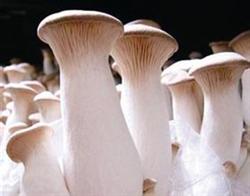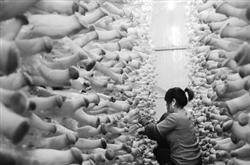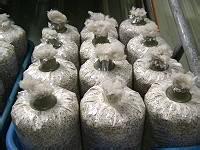New technique of bag planting and covering soil of Pleurotus eryngii

Pleurotus eryngii, also known as Pleurotus ostreatus, is one of the rare edible fungi. Its meat is thick, crisp and tender, milky white in color, delicious in taste and rich in nutrition. It is known as "meat in vegetarian". By using the following new indoor and outdoor soil covering cultivation techniques, the biological biodegradability can reach 100%, 120%, and the mushroom body has good commercial properties, and the benefit can be increased by 15%, 20%, compared with non-soil-covering cultivation. 1. Biological characteristics (1) the mycelial growth temperature is 6 Mel 30 ℃, the optimum temperature is 18 Mel 25 ℃, the formation temperature of primordium and fruiting body is 10 Mel 20 ℃, and the optimum temperature is 15 mi 18 ℃. (2) during the mycelial growth stage, the water content of the culture medium is 60% Mel 65%, the air relative humidity is 60% Mel 70%, and the humidity exceeds 80%. The mycelium grows slowly, but in the fruiting body formation and development stage, the relative humidity requires 90% Mel 95%. (3) fresh air is needed in both mycelium growth and fruiting body growth and development, especially sufficient oxygen is needed for primordium formation and fruiting body differentiation. (4) the growth of mycelium does not need light, but the formation and differentiation of fruiting body needs some scattered light. (5) the suitable range of PH value of culture material is 6mur8. Second, the culture material formula cotton husk, miscellaneous sawdust, corncob, bagasse, waste cotton and so on can be used as cultivation raw materials, in order to match the effect is better. Reference formula: (1) 50% miscellaneous sawdust, 30% cottonseed hull, 15% wheat bran, 3% corn flour, 1% sucrose and 1% lime; (2) 40% miscellaneous sawdust, 38% cottonseed hull, 20% wheat bran, 1% sugar and 1% lime. (3) 24% sawdust, 30% cottonseed hull, 25% wheat bran, 20% corncob, 1% lime. The water content of the mixture adjusted according to the above formula is 60%. Third, bag sterilization and inoculation culture material mix well, sugar and lime to water, then mix into the mixture. Bagging machine can be used to pack bags, and the specifications of bacterial bags are 15 cm × 30 cm × 0.05 cm or 17 cm × 30 cm × 0.05 cm polyethylene or polypropylene plastic bags. Bagging requires appropriate tightness, bagging with rings and sterilization according to conventional methods. When the temperature of the bag drops below 30 ℃, make a hole in the middle of the bag with a pointed stick with a depth of 2 to 4. This is beneficial to mycelium germination. Fourth, the management of the germicidal period. After inoculation, the bacteria were transferred to the culture room to send bacteria. The culture room should choose a dry, ventilated, moisturized and clean room with a room temperature of about 25 ℃ and a relative humidity of 60%. Ventilated for 2 hours every day, and at noon when the temperature is low. The culture room can be set up, which is divided into 4 layers, 2 m-2.5 m high, 2 m-4 m long, 0.5 m-0.8 m high and 0.6 m wide. The low temperature season should be warmed up. If there is an infected bag, remove it and burn it in time. 5. The management of mushroom production can be moved into the cultivation room when the mycelium is fed more than 4pm for 25 days. The temperature in the cultivation room was kept at 10 ℃ and 18 min. Remove the ring lid from the bacterial bag and strengthen ventilation to promote mycelium maturation. 5Mel 10 days when the primordium is ready to form, remove the collar and dig out the old bacteria at the mouth of the cave. After 7 days, when the fruiting body primordium is formed, fold the mouth of the bag or cut off the bag membrane with a knife and keep 1 cm. When the fruiting body slowly expands, the temperature is kept at about 16 ℃, and the air relative humidity is 85% RH 95%. Too low or too high humidity will affect the quality of the fruiting body. According to the situation, spray water in the air 3 times a day, do not spray water directly on the mushroom body (otherwise the mushroom body is prone to yellowing). Strengthen ventilation, poor ventilation is easy to cause deformed mushrooms. 6. Pleurotus eryngii is full of mushroom buds, and most of the mushroom buds are not supplied with nutrients, so that the fruiting body is too small, affecting the quality. Lei should be soothed in time at this time. The method is to select those small, malnourished and deformed mushrooms with sterilized blades, cut them off smoothly under the expanded stalk, close the doors and windows, and stop spraying water for one day. 7. Harvest the mushroom body with a large, round and smooth mushroom cover and a flat mushroom cover from convex circle to plane. When harvesting, use a sterilized knife, pinch the mushroom with the left hand, cut out between the base of the stalk and the mycelium, and be careful to avoid injury to the next mushroom. If the mushroom is inconvenient to cut out, it can be twisted and picked by hand (do not break hard, lest the whole mycelium is separated from the culture medium). The collected mushrooms are classified and stored. Eighth, the soil covering management chooses to build a shed with agricultural film and sunshade net, which is rich in humus and slightly fertile and loose. The border bed is 10ml 15cm deep and 130mm 150cm wide, regardless of length. Mix with 2% lime water and 80% dichlorvos 500 times solution into the soil. After the first tide mushroom is harvested, clean up the mushroom bag and move it into the border bed, which can be placed horizontally or vertically. Filled with fine soil on all sides, the bag is covered with soil 2mi 3cm thick, and the bed is moisturized with straw and straw. Then spray water on the bed to get wet on the bed. Cover the small arch shed with 2m / m for 3 days, ventilate 1 / m / m for 2 times a day, and spray small water. The fruit bodies can be harvested after 15 days of soil mulching and 15 days of budding. 9. Disease and pest control of Pleurotus eryngii is rare and prone to insect pests, mainly small bacteria mosquitoes, fungal lean mosquitoes and golden-winged mushroom mosquitoes. In the process of fruiting body growth, due to high humidity or poor ventilation, it is easy to cause mushroom body decay or rotten bacteria bags, feces, weeds and garbage near the cultivation site to spread insect pests. At the initial stage, particles or filamentous viscous transparent bodies are formed on the surface of the fruiting body, which is similar to glue, which is caused by the ovulation of mosquitoes on the fruiting body. After a few days, the larvae (which are difficult to observe with the naked eye) are first harmful fruiting body primordia, and then feed on the fruiting body. The injured part is concave and yellowish brown; in severe cases, it is purplish brown with a bad smell and a layer of mucus on the surface. Some of the malformed mushrooms were eaten hollow. If it is not killed in time, it will cause serious losses, or even no harvest. Prevention and control methods: 1, give priority to prevention, the cultivation field should choose a clean place, good ventilation, no livestock and poultry, weeds, feces around the mushroom house. 2. Conditional mushroom doors and windows are equipped with insect-proof nets or gauze to prevent adults from flying into and laying eggs. 3. Before use, disinfect the cultivation room with 5% lime water and trichlorfon. 4. After picking the mushrooms, spray them with cypermethrin 1000 times or trichlorfon EC. 5. Clear the infected bag in time, bury it deeply or burn it.
- Prev

Brief introduction of artificial cultivation and Management techniques of Pleurotus eryngii
Pleurotus eryngii Pleurotuseryngii (DC.exFr) Quel belongs to the genus Pleurotus ostreatus, fungal phylum, basidiomycetes, Basidiomycetes, Pleurotus ostreatus, Pleurotus ostreatus. Pleurotus ostreatus, also known as Pleurotus ostreatus, mainly occurs in dead plants of the umbel family Umbelliferae (root.
- Next

Anti-fouling technology of bag cultivation of Pleurotus eryngii
Pleurotus eryngii, Pleurotus eryngii and Pleurotus ostreatus are edible mushrooms with high benefits, and many counties and cities in the country have been listed as the leading industries. At present, it is mainly cultivated by the method of clinker (high temperature sterilization). Due to the complexity of technology, most growers are seriously polluted by miscellaneous bacteria, such as lack of production experience, extensive cultivation and so on.
Related
- Fuxing push coffee new agricultural production and marketing class: lack of small-scale processing plants
- Jujube rice field leisure farm deep ploughing Yilan for five years to create a space for organic food and play
- Nongyu Farm-A trial of organic papaya for brave women with advanced technology
- Four points for attention in the prevention and control of diseases and insect pests of edible fungi
- How to add nutrient solution to Edible Fungi
- Is there any good way to control edible fungus mites?
- Open Inoculation Technology of Edible Fungi
- Is there any clever way to use fertilizer for edible fungus in winter?
- What agents are used to kill the pathogens of edible fungi in the mushroom shed?
- Rapid drying of Edible Fungi

